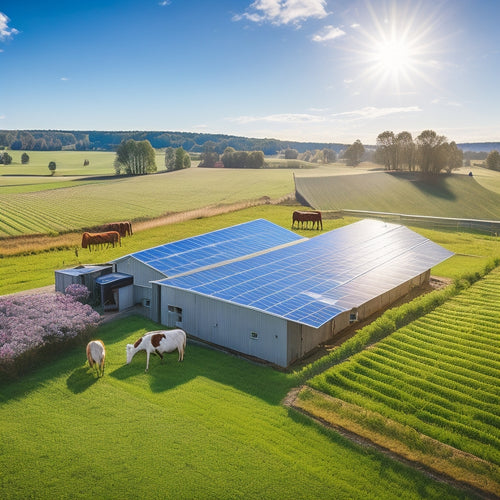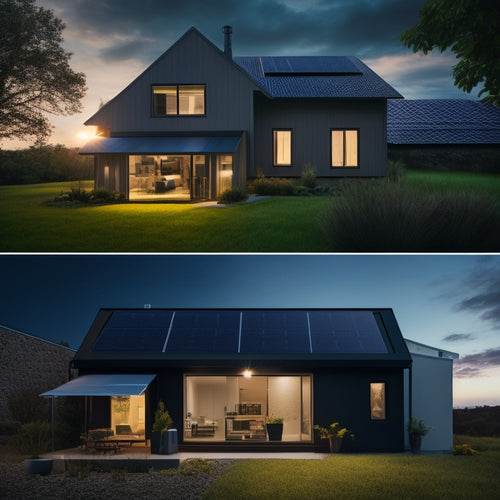
Implementing Microgrid Solutions for Energy Resilience
Share
Implementing microgrid solutions is a strategic approach to improve your energy resilience. By utilizing localized energy generation from sources like solar and wind, you can considerably cut costs and reduce dependence on centralized power. Enhanced energy storage systems guarantee you maintain power during outages and high demand. Local Energy Management Systems allow real-time monitoring, optimizing efficiency. Additionally, this model minimizes transmission losses by producing energy close to consumption sites. With a well-planned strategy, you can achieve energy independence and sustainability while addressing your community's unique needs. Higher performance and deeper understandings await as you investigate the specifics.
At a Glance
- Microgrids utilize localized energy generation, reducing costs and enhancing energy independence through renewable resources like solar and wind.
- Energy storage systems, such as advanced batteries, manage supply fluctuations and ensure reliable power during outages or peak demand periods.
- Local Energy Management Systems (LEMS) optimize energy usage with real-time monitoring and demand response strategies, improving efficiency and reliability.
- Integrating a diverse mix of renewable energy sources enhances sustainability and compliance with regulations, fostering community engagement and resilience.
- Reducing transmission losses through local generation contributes to improved system efficiency and a more resilient energy infrastructure.
Cost-Effective Energy Independence
When you consider cost-effective energy independence, reducing energy expenses becomes a key objective.
By investing in localized energy generation, you can greatly lower utility bills while enhancing your control over energy sources. This strategic approach not only encourages financial savings but also strengthens your resilience against fluctuating energy markets.
Additionally, implementing energy storage solutions, such as solar batteries, can optimize your energy management and maximize savings potential over time by effectively utilizing renewable energy resources effective energy management.
Reducing Energy Expenses
As the demand for energy continues to rise, finding cost-effective solutions for energy independence becomes essential for both businesses and homeowners. One effective strategy you can adopt is implementing microgrid solutions to reduce energy expenses considerably. By utilizing localized energy resources, you can achieve substantial energy savings while maintaining control over your energy supply.
Smart energy management systems allow you to monitor and optimize your energy consumption, leading to budget optimization. This not only helps you identify peak usage times but also provides knowledge into how to adjust your habits for lower costs. By integrating energy-efficient appliances and renewable energy sources, you can further decrease your reliance on the grid, mitigating fluctuating energy prices.
Moreover, investing in energy storage solutions will enable you to capitalize on off-peak energy rates, storing surplus energy for later use. This flexibility enables you to make strategic decisions that promote financial freedom while enhancing energy resilience.
Ultimately, adopting microgrid solutions positions you to minimize energy expenses, achieve sustainable independence, and welcome a future where you're less vulnerable to external energy market fluctuations.
Localized Energy Generation
Localized energy generation offers a powerful pathway to achieving cost-effective energy independence. By utilizing local resources—like solar panels, wind turbines, or biomass—you can reduce reliance on external energy sources and mitigate the impact of fluctuating utility prices. This approach not only stabilizes your energy costs but also enables your community to take charge of its energy future.
Effective community engagement is essential in this process. When you involve local stakeholders in planning and implementation, you strengthen support for localized systems, ensuring they meet the specific needs of your area.
However, you must maneuver through regulatory challenges that often accompany the shift to decentralized energy systems. Understanding local laws and regulations can help you identify potential obstacles and find solutions that align with both community goals and legal requirements.
Investing in localized energy generation isn't just about economics; it's about freedom. By taking control of your energy resources, you enhance your community's resilience, promote sustainability, and create a model for others to follow.
Seize this opportunity to lead your community towards a future where energy independence isn't just a dream, but a tangible reality.
Enhanced Localized Energy Control
Enhanced localized energy control enables you to optimize energy usage and improve resilience in your microgrid.
By implementing Local Energy Management Systems, you can monitor and adjust energy flows in real-time, ensuring efficiency and reliability. This approach is crucial for maximizing the benefits of accurate system design, which considers daily energy needs and seasonal variations.
Additionally, incorporating demand response strategies helps balance supply and demand, further enhancing your energy independence and stability during peak times.
Local Energy Management Systems
Local Energy Management Systems (LEMS) play an important role in optimizing energy use within microgrids, guaranteeing that every kilowatt is effectively employed. By implementing advanced LEMS, you can enhance localized energy control, making your microgrid more resilient and efficient. These systems employ demand forecasting to predict energy needs, allowing for strategic distribution based on real-time data.
Moreover, LEMS facilitate grid interoperability, enabling seamless communication between diverse energy sources. This is vital for maintaining balance and reliability within your microgrid.
Here's a quick overview of key LEMS features:
| Feature | Description | Benefits |
|---|---|---|
| Demand Forecasting | Employs analytics to predict usage | Reduces waste, optimizes supply |
| Grid Interoperability | Guarantees compatibility among systems | Enhances reliability and flexibility |
| Real-time Monitoring | Tracks energy flows instantaneously | Increases responsiveness |
| Automated Controls | Adjusts energy distribution autonomously | Minimizes human error |
| User Interface | Provides intuitive dashboards | Simplifies management |
Demand Response Strategies
Demand response strategies serve as a crucial mechanism for optimizing energy consumption and enhancing the efficiency of microgrids. By actively engaging consumers in their energy use, these strategies enable you to take control of your consumption patterns and adapt to real-time market conditions.
Changing pricing plays a crucial role here, offering financial incentives that encourage you to shift your energy use during peak demand periods. When you understand how demand response works, you can make informed decisions about when to use energy-intensive appliances, reducing strain on the grid and lowering costs.
This not only maximizes your savings but also contributes to the overall resilience of the microgrid. Consumer engagement is essential in this process. By cultivating a culture of proactive energy management, you can participate in programs that reward you for reducing your load during high-demand times.
This engagement alters passive energy consumption into an active partnership with the grid, aligning personal interests with collective benefits. Ultimately, demand response strategies create a win-win scenario, where you gain freedom over your energy choices while enhancing the reliability and sustainability of the microgrid.
Key Components Overview
To effectively implement a microgrid, you need to understand its key components, particularly energy storage systems and control systems design.
Energy storage systems, such as those utilizing battery technology, are crucial for ensuring a reliable power supply, as they store excess energy generated from renewable sources for use during peak demand or outages.
Additionally, control systems design orchestrates the operation and integration of the entire microgrid, ensuring ideal performance and energy management key installation considerations.
Together, these elements form the backbone of energy resilience, enabling you to maintain stability and efficiency in varying conditions.
Energy Storage Systems
Energy storage systems are vital for enhancing the resilience of microgrids, allowing them to effectively manage fluctuations in energy supply and demand. By integrating advanced battery technologies, you can store excess energy generated during peak production times and release it during periods of high demand or limited generation. This capability not only stabilizes your microgrid but also maximizes the efficiency of renewable energy sources, like solar and wind.
When considering grid integration, it's important to select the right battery technology that aligns with your specific needs. Lithium-ion batteries are popular for their high energy density and rapid response times, while flow batteries offer scalability and longer discharge durations. Both options provide unique advantages that can improve your microgrid's performance.
Incorporating these energy storage solutions allows you to achieve greater independence from traditional power sources, promoting a sense of freedom in energy management.
Control Systems Architecture
Optimizing control systems design is essential for the effective operation of microgrids, as it integrates various components that manage generation, storage, and distribution of power.
Control algorithms play a significant role in ensuring system reliability, enabling real-time monitoring and adjustments. By employing advanced data analytics, you can assess performance and enhance operational flexibility, adapting to changing energy demands.
To achieve this, strong communication protocols are important. They facilitate seamless interaction between decentralized management systems, allowing for efficient coordination among generation sources, storage units, and end-users.
User interfaces must be intuitive, allowing you to make informed decisions quickly.
Furthermore, network security is a top priority. As microgrids become more interconnected, protecting against cyber threats is crucial to maintaining functionality and trust.
Incorporating these elements supports performance optimization while ensuring that your microgrid operates resiliently under various conditions.
Selecting Based on Energy Demand
To effectively select a microgrid solution, you need to assess your energy consumption patterns. Understanding these patterns allows you to identify peak demands and potential efficiencies.
By integrating renewable energy sources such as solar power solutions, you can enhance resilience and reduce reliance on traditional grids, aligning your strategy with sustainable goals.
Additionally, integrating renewable energy sources can enhance resilience and reduce reliance on traditional grids, aligning your strategy with sustainable goals.
Assessing Energy Consumption Patterns
Understanding energy consumption patterns is crucial for selecting the right microgrid solutions tailored to your specific energy demand. By conducting a thorough behavioral analysis, you can gain understanding into how energy is used within your community or facility. This analysis helps you identify peak usage times, seasonal variations, and overall consumption trends.
Usage forecasting plays a critical part in this process. By predicting future energy needs based on historical data, you can make informed decisions about the size and capacity of your microgrid. This foresight guarantees that the system you implement isn't only efficient but also adaptable to changing demands.
As you assess your energy consumption patterns, consider the diverse needs of various stakeholders. This strategic approach allows you to accommodate different consumption behaviors while maximizing energy resilience.
Ultimately, understanding these patterns equips you to design a microgrid that aligns with your unique situation and goals. This way, you can utilize energy independence, reduce reliance on the grid, and enhance your community's overall resilience.
With the right understanding, you're not just reacting to energy needs; you're proactively shaping a sustainable future.
Integrating Renewable Energy Sources
Integrating renewable energy sources into your microgrid requires a strategic selection process that aligns with your energy demand. Start by evaluating the viability of solar panel integration; it's often the most accessible option for residential and community solar projects.
Consider wind energy implementation next, as wind resources can provide a considerable energy increase, particularly in windy regions. Biomass utilization and geothermal systems can also improve your energy mix, especially in areas rich in organic materials or geothermal resources.
Think about incorporating hydroelectric options if water sources are available, as they offer reliable and constant energy generation. Virtual power plants can help optimize these resources by aggregating distributed energy sources, enhancing microgrid scalability.
Make sure that your chosen renewable energy sources comply with existing regulatory structures, as this will smooth the integration process and safeguard against future compliance issues.
Lastly, don't overlook energy efficiency measures; they can notably reduce your overall energy demand, making it easier to achieve a balanced, resilient microgrid.
Reduced Transmission Losses
When you enhance local generation within a microgrid, you greatly reduce transmission losses associated with long-distance energy transport.
By producing energy closer to where it's consumed, you minimize the energy that's lost as heat during transmission.
This strategic approach not only improves efficiency but also contributes to a more resilient energy system.
Enhanced Local Generation
Enhanced local generation greatly reduces transmission losses, making energy systems more efficient and resilient. By utilizing resources like solar panels or wind turbines within your community, you can generate power closer to where it's consumed, minimizing the distance electricity must travel. This shift not only enhances efficiency but also engages local stakeholders in energy innovation, nurturing a sense of ownership and responsibility.
To maximize the benefits, you'll need to focus on technology integration and grid automation. Implementing smart metering allows real-time data monitoring, optimizing energy use while reducing environmental impact.
Additionally, effective resilience planning incorporates community engagement, ensuring that all voices are heard in the decision-making process. Navigating the regulatory structures and securing policy incentives is vital for supporting these initiatives.
Collaborating with stakeholders, including local governments and private enterprises, can help streamline these efforts. By prioritizing enhanced local generation, you're not just improving energy systems; you're creating a strong foundation for future energy resilience.
Ultimately, this strategy enables a free and empowered community, capable of adapting to the challenges of tomorrow while maintaining sustainable practices today.
Frequently Asked Questions
What Are the Environmental Benefits of Microgrid Solutions?
Microgrid solutions cut your carbon footprint by enhancing energy efficiency and integrating renewables. They reduce pollution, promote habitat preservation, and elevate biodiversity, creating a cleaner environment that aligns with your desire for sustainable, independent energy choices.
How Do Microgrids Impact Local Job Creation?
Microgrids can greatly enhance local job creation by offering job training programs, nurturing economic growth, and promoting sustainable employment. Engaging the community in these initiatives strengthens individuals, ultimately leading to increased freedom and resilience in the workforce.
Can Microgrids Operate During Natural Disasters?
Think of microgrids as lifeboats during storms. They can operate during natural disasters, ensuring energy independence and enhancing disaster response capabilities, allowing communities to stay resilient and connected when traditional power sources fail.
What Role Do Energy Storage Systems Play in Microgrids?
Energy storage systems enhance microgrid performance by improving energy management and facilitating technology integration. They enable you to store excess energy, ensuring a reliable power supply and greater autonomy during disruptions, strengthening your energy independence.
How Do Regulations Affect Microgrid Implementation?
You might think regulations stifle innovation, but they actually shape microgrid implementation. Steering regulatory structures and permitting processes can release opportunities, ensuring you utilize energy independence while adhering to necessary guidelines for sustainable development.
Explore More
In the expedition toward energy resilience, implementing microgrid solutions is like planting seeds in fertile soil; with careful nurturing, they grow into a sturdy ecosystem. By embracing cost-effective independence and enhanced localized control, you're not just reducing transmission losses—you're cultivating a sustainable future. As you select systems based on your unique energy demands, remember that every decision shapes the terrain of your energy independence, ensuring that your community thrives in the face of challenges.
Related Posts
-

What Do I Need to Know About Farm Solar Panels
When considering farm solar panels, you need to assess costs, benefits, and technical specifics. Initial investment c...
-

Essential Hiking Lights for Safety and Fun
When you're hitting the trails, essential hiking lights are vital for safety and fun. A lightweight headlamp offers h...
-

Cost of Home Solar Battery
You're looking to invest in a home solar battery to reduce your grid reliance, but you're curious about the cost. The...


